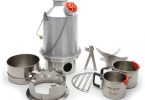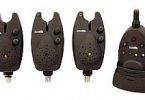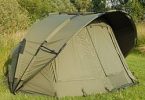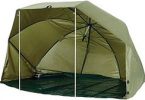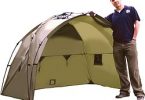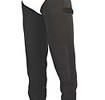It’s a minefield out there! Rigid frames, domes, brolly systems, shelters – With so many bivvies available, how do you choose the one that’s right for you?
My first bivvy was not really a bivvy at all; more of a battered old tent that had seen better days. Luckily it was dark brown in colour, had it been a garish orange like most tents seem to be nowadays, I doubt I’d have even been let near a water in it, let alone get a year’s use out of it on the bank. It was no fashion icon, far from it, but as a kid it was all I could afford, and the flea-bitten sun-lounger that went with it was not much better! The thing is, it did the trick, and it enabled me to get out on the banks session fishing. What’s more, if I were in the same situation today, then I would happily use the same tent again. You see, one important point to make right at the start is that choosing the right bivvy should be about finding a product that matches your exact needs, not selecting the one that looks the best or costs the most. I have seen too many anglers make that mistake, so don’t be fooled into thinking that the best products have to be those with the largest price tag, sometimes just the opposite can be the case.
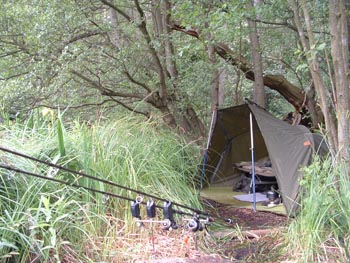
So, where do we start? Well, it’s all about usage; you need to find a bivvy that is going to suit your style of fishing. Have a think about the kind of night fishing you intend to be doing and ask yourself a few basic questions;
Are you looking at single overnighters or long sessions?
Session duration is the probably the most important factor. If you only fish the odd overnight session here and there, and only for a night at a time, then you are probably best looking at a shelter or brolly system, or, if you want a bit more room, a cheap-end dome system. The main benefit being that they are much cheaper than a full rigid frame design bivvy and as you are not going to be using it much, there’s no point spending stupid money. However, if you are going to be using it all weekend every weekend, then you will need something a little more substantial.
This is where the rigid frame designs come in. They are effectively work horse bivvies, designed to do the same thing week in week out, and offer shelter and durability no matter what the weather might throw at you. Also, because you are likely to be fishing for greater amounts of time, they usually offer more space to accommodate more tackle and some even feature extra porches through use of additional winter skins that enable you to store gear that you might not necessarily want within the living quarters, but that which you still will want to keep sheltered all the same; like smelly fishing bait, particle tubs, chest waders or wet garments.
What kind of waters are you likely to be fishing; easily accessible or off the beaten track?
Practicality is key. If you have to walk three miles from the car, or the swims on the lake are only going to be a few feet wide, then common sense would tell you that a huge 2-Man rigid frame bivvy with an extended winter skin is probably going to be too much, not just because it will give you a coronary each time you have to do the walk from the car park, but once there you’ll struggle to find the space to get it up. Again, think about the waters you are going to be fishing, think lightweight design for tricky swims and long walks, or bigger and with optional extras if your intended lakes have roomy and easily accessible swims.
Do you like to carry a lot of gear for fishing, camping and cooking or will you be travelling light with the bare essentials?
If you fancy yourself as a bit of a Gordon Ramsey when out on the bank or if you like to take more tackle than everybody else on the water put together, then again, you need to think about space. Brollies and shelters are ideal for those who like to travel light whereas those who prefer the kitchen sink approach will need to ‘go large’ in order to accommodate all their ‘essentials’.
Static or roaming?
Another hey point is how you like to fish. If you tend to stay static, i.e. once you’ve set up on a swim you see it through for better or for worse, then a bivvy that takes a bit of setting up or breaking down will be OK. However, if like me you tend to move about quite a bit and may change swims several times over a long session, then you need to be looking at a bivvy with quick set-up and breakdown times.
Fair weather fisherman?
If you only tend to do overnighters when the sun is shining and the nights are long, then a lightweight brolly or shelter system should be fine, but if you like to do some winter sessions as well, then you need to be looking for a bivvy with a bit of meat; not just in terms of keeping out the cold but for standing up to harsh winds. Brolly systems and shelters have a tendency for the spurs or poles to invert in heavy winds (just like a normal umbrella does when it’s windy) whereas a rigid frame design should stay rock solid throughout.
Budget
You need to think about your budget. It’s no good forking out three hundred pounds for a bivvy if you then realise you need to buy storm poles, winter skins and ground sheets, all of which might cost another £200.00 you haven’t got! First you need to decide on the type of bivvy that suits your needs; rigid frame, shelter, brolly, etc. Then once you have decided on a type, find one within your budget. Within each sector there are budget and top-end models, so there should always be something to suit your purse.
However, just because it’s cheap does not mean it’s a bargain, and likewise, just because it’s expensive does not mean it’s the best. Although there is a tendency to think you have to have one now, if it’s something that is going to get a lot of use, then my advice would be to save for longer and purchase something further up the scale. If you buy a thirty quid bivvy and expect it to last as long as a two hundred quid bivvy, then chances are you’re going to end up disappointed.
Summary
Choosing the right bivvy can often be a personal thing, as only you will actually know what suits you best. Try not to be swayed by what others might say; yes, their bivvy might be the best for them, but that does not necessarily mean it’s the right one for you!
Well that’s about it really, hopefully once you’ve factored in all of the above you will be left with some answers. However, one final point that’s worth remembering is adaptability. Most modern day bivvies can be adapted to different fishing styles, so be sure to check out all the features to see what they can and can’t do. Sometimes it’s not as easy as choosing A or B when looking at what will suit you best. Sometimes it might need to be a bit of A and B, and that’s where the versatility
of a particular bivvy might make it the clear favourite as on one hand it might be a rigid frame bivvy suitable for fishing in the depths of winter, but remove a few bits and pieces and you are left with a lightweight open fronted system ideal for summer overnighters.
As a last point it’s also worth mentioning that there is nothing to stop you having more than one, if your budget can stretch to it. Many anglers I know have two bivvies; a lightweight brolly or shelter for summer use and a full rigid frame bivvy for session and winter work.
It’s all down to practicality, and finding a bivvy (or bivvies!) to suit you.
Tight Lines…
Julian Grattidge
Article taken from: http://www.Bivvies.co.uk – The Carp Bivvy information website
Bivvies For Sale


